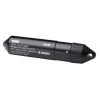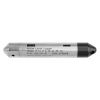Onset HOBO MX2001 Water Level Loggers
Features
- Wireless data offload to mobile devices or Windows computers via Bluetooth
- Integrated barometric pressure sensor enables direct water level readout
- Powered by two user-replaceable AA batteries in the top-end unit
- Expedited repair and warranty service
- Lifetime technical support
- More
Overview
The HOBO MX2001 water level data logger is designed for convenient wireless setup and download from mobile devices via Bluetooth Low Energy. The MX2001 consists of a top-end logger unit and water level sensor. The logger simplifies and lowers the cost of field data collection by providing wireless access to high-accuracy water level and temperature measurements right from a mobile phone, tablet, or Windows computer, with Onset's free HOBOconnect app. Direct-read cables (sold separately) can be ordered in lengths from 0.2 to 500m for deployment in a wide range of wells.
Benefits
- Integrated barometric pressure sensor enables direct water level readout
- Direct-read cable connects the sensor to top-end logger/transmitter
- Cables are reinforced with Kevlar
- Cables are interchangeable, so loggers are easy to redeploy in future applications
- Cable length can vary up to 3% from the length ordered
- Available cable lengths are 1, 5, 10, 15, 30 and 60 meters
- Reference water level can be entered at the start of the deployment
- Use HOBOconnect for setup, data viewing, and data sharing
- Several logging modes: normal, multi-rate logging and event-triggered burst-logging
- Durable ceramic sensor
- Available with stainless steel or titanium sensor ends
- 3-point NIST-traceable calibration certificate included for the water pressure sensor
- HOBO MX2001 consists of a top-end logger unit and water level sensor
- Two AA 1.5 V batteries
In The News
Save our Bogs! Culture, Conservation and Climate Action in Ireland’s Peatlands
Characterized by long-term accumulation under waterlogged conditions, peatlands exist on every continent and account for 3-4% of the global land surface . Small but mighty, these often overlooked wetland environments are estimated to hold as much as one-third of the world's organic carbon in their soil—twice the amount found in the entirety of the Earth's forest biomass. While healthy peatlands can trap and store carbon, regulate water, and provide important habitats for rare species, human alteration has disturbed peatland carbon and nitrogen cycles on a global scale. Approximately 12% of the world’s peatlands have been drained and degraded through conversion for agriculture, forestry, infrastructure development, and other uses.
Read MoreSargassum Surge: How Seaweed is Transforming our Oceans and Coastal Ecosystems
Until recently, Sargassum –a free-floating seaweed–was distributed throughout the Sargasso Sea , the north Caribbean Sea, and the Gulf of Mexico. But in the space of a decade, this seaweed has, as one scientist remarks , “Gone from a nonfactor to the source of a terrible crisis.” Driven by climate change, anomalous North Atlantic Oscillation in 2009-2010 and a glut of anthropogenic pollutants, sargassum has proliferated. Seasonally recurrent mats as deep as 7m now bloom in the “Great Atlantic Sargassum Belt” (GASB), which covers areas of the Atlantic from West Africa to the Caribbean Sea and Gulf of Mexico. Every year, millions of tons wash up along the shores of more than 30 countries . Dr.
Read MoreGreat Lakes Research Center: Designing Targeted Monitoring Solutions
According to the National Oceanic and Atmospheric Administration ( NOAA ), the Great Lakes have more miles of coastline than the contiguous Atlantic and Pacific coasts combined and contain 20 percent of the world's freshwater, making it a critical region to protect and conserve. Continuous monitoring and data-informed resource management are key components of managing waters in the region. Hayden Henderson, a research engineer with the Great Lakes Research Center (GLRC), designs and deploys monitoring platforms throughout the Great Lakes. With a background in environmental engineering, Henderson enjoyed the challenge of creating systems and making them work to obtain difficult, remote measurements.
Read More



















